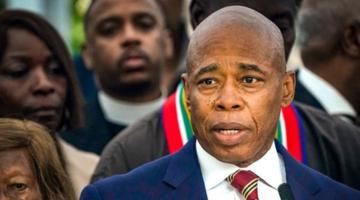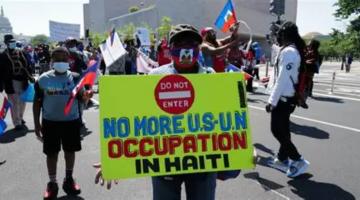Mayor Eric Adams speaks during the NYPD graduation in New York City on July 25, 2023. NY Daily News via Getty Images
A proposed New York training facility shows how establishment politicians only understand governance through policing.
Originally published in The Intercept.
Mayor Eric Adams announced last Friday that the city would spend at least $225 million on a new police training facility in the borough of Queens. The mayor’s decision to pour further public funding into policing comes as he slashed services to the city’s most vulnerable, including cutting library budgets by $58.3 million.
The priorities could not be clearer. Like many politicians across the country, the mayor wants to disinvest from public services and privatize them, while instead increasing mass policing and carceral enforcement as a response to social problems.
To see just how much Adams has become the paragon of governance through policing, one need only look at the intended purposes of the police training facility. The site will be used to train law enforcement officers for all the city’s agencies — including the departments of Sanitation, Homeless Services, the Administration for Children’s Services, and the Taxi and Limousine Commission — under one roof, alongside New York Police Department officers.
In response to the mayor’s announcement, a number of commentators on social media decried the plan as a “Cop City” for New York — the term used to describe a vast police training facility under construction in Atlanta, which will swallow up crucial forest land in that city.
Despite the fact that the Atlanta facility will be a compound of over 85 acres, the cost is estimated to be a ballooning $109 million — less than half the amount New York City is dedicating to its new training building.
The analogy is not perfect — the New York facility will be built on land already occupied by police, at the NYPD Police Academy Campus — but like the Atlanta project, Adams’s plan will be dedicated to multi-agency training under the misleading label of “public safety.”
If the planned building itself is not quite a “cop city,” it reflects an agenda that sees the whole of New York as a cop city. Consider, for instance, that Adams himself is a former cop.
Eighteen city agencies already have law enforcement officers among their ranks, although in numbers far smaller than the leviathan NYPD’s 36,000 cops. The New York City Department of Health and Hospitals has 1,250 so-called special officers, for example, and Sanitation employs 80 special patrol officers.
While most of these law enforcement officers don’t carry guns, the “peace officer” label should not apply to agents who carry batons, handcuffs, and in some cases weapons like Tasers. What they all have is permission to use physical force against civilians.
An investigation published in April by New York Focus found numerous repeat instances of abuse, including beatings, carried out by over two dozen “peace officers” with the Department of Homeless Services Police.
But Is NYPD Training Any Good?
The idea that all the city’s law enforcement officers will be trained in the manner of NYPD cops promises only more violent outcomes. NYPD misconduct settlements cost the city over $500 million in the last six years, and $115 million in 2023 alone.
The mayor’s own words on the virtues of consolidating law enforcement training bode ill for the new Queens facility.
“We will learn from the Department of Correction of how they’re able to identify gang behavior within their walls,” Adams said in Friday’s press conference. “We will learn from the Department of Probation as they see those probationary individuals who are continuously committing crimes or who are attempting to turn their lives around.”
The centralized training, then, is aimed at reinforcing practices of criminalization that treat certain groups and individuals — disproportionately poor people of color — as threats worthy of constant policing and surveillance.
When announcing the training center, Adams invoked a unified force of “bad guys of this city” without clarifying who or what he meant, but his fearmongering statements echoed similar claims — that organized, professionalized groups were responsible for sowing disorder — used to justify brutal police responses to the 2020 George Floyd uprisings and, more recently, raids on Palestine solidarity encampments at college campuses.
Adams’s agenda, meanwhile, exemplifies what abolitionist geographer Ruth Wilson Gilmore calls “organized abandonment.” Gilmore describes a divestment by the state from essential services from poor and working-class communities, leaving opportunities for privatization and extraction, while relying increasingly on extensive policing and carceral solutions to maintain a violently racist order. Attendant myths of marauding and devious criminal enterprises serve as rhetorical cover.
Prosecutors in Atlanta have deployed the same pernicious logic to Cop City protesters on extreme and overreaching charges, frequently under Georgia’s expansive Racketeer Influenced and Corrupt Organizations Act. As The Intercept reported, the RICO indictment cites typical social justice activities such as “mutual aid,” writing “zines,” “collectivism,” and raising funds for legal fees as proof of criminal conspiracy.
Construction on the New York City police training building will begin in 2026 and the facility is planned to open in 2030. Unlike Atlanta’s Cop City, the fight against the facility in New York can’t have the same territorial dimension. Atlanta’s Stop Cop City movement is still fighting to save the acres of forest on which the police compound is to be built, and that land has been a site of protest mobilizations and encampments for over two years.
The area planned for the New York building is already cop territory. Yet there is room for New Yorkers to stake out their objections, just as opposition to Cop City has expanded far beyond the Atlanta forest, with protesters taking aim at the headquarters of the project’s corporate backers and contractors nationwide.
The fight against a “cop city” in New York cannot focus solely on a Queens police training campus. The mayor’s plan, after all, is a grim reminder that, four years after the George Floyd uprisings, Cop City is everywhere.
Natasha Lennard is a columnist for The Intercept. Her work has appeared in The Nation, Bookforum, and the New York Times, among others. She is the associate director of the Creative Publishing & Critical Journalism graduate program at the New School for Social Research in New York. She is the author of “Being Numerous: Essays on Non-Fascist Life.”



















